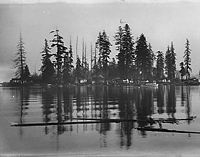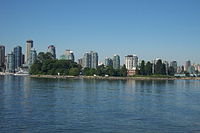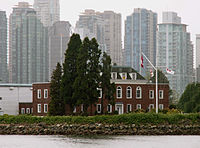- Deadman's Island (Vancouver)
-
Deadman Island is a 3.8 ha island to the south of Stanley Park in Coal Harbour in Vancouver, British Columbia. The indigenous Sḵwxwú7mesh name is "skwtsa7s", meaning simply "island." Officially designated "Deadman Island" by the Geographical Names Board of Canada in 1937.[1] it is commonly referred to as Deadman's Island. Vancouver's Naval Reserve Division, HMCS Discovery, is strategically located on the island in support of the security of Vancouver Harbour. The facility housed the Joint Maritime Operations Centre for the APEC Summit in 1997 and the 2010 Winter Olympics. In addition to the Naval Reserve, RCSCC Corps 47 Captain Vancouver and NLCC Captain Rankin have their weekly parades at HMCS Discovery and the facility houses a naval museum. The island is connected to the mainland of Stanley Park at low tide, and otherwise via a short timber-structure bridge.
Early history
One of Vancouver's first white settlers, John Morton, visited the island in 1862. Morton discovered hundreds of red cedar boxes lashed to the upper boughs of trees and one had evidently fallen and broken to reveal a jumble of bones and a tassel of black hair. The island was the tree-burial grounds of the Sḵwxwú7mesh. Undeterred, Morton took a fancy to the island and attempted to acquire it. He changed his mind when Chief Capilano pointed out that the island was "dead ground" and was a scene of a bloody battle between rival tribes in which some two hundred warriors were killed. It's said that "fire-flower" grew up at once where they fell, frightening the foe into retreat.[2] The macabre name of the island is thought to reflect this history, although the Squamish name is simply skwtsa7s, meaning "island."[3]
Settlers continued to use the island as a cemetery prior to the 1887 opening of Mountain View Cemetery. Between 1888 and 1892, Deadman Island became a quarantine site for victims of a smallpox epidemic and burial ground for those who did not survive.[4]
The Ludgate Affair
This small islet again became the site of conflict when Theodore Ludgate leased the island from the federal government in 1899, to the chagrin of the mayor and other civic officials who assumed that it was included in the original Stanley Park land grant. Mayor Garden, with police accompaniment, tried to prevent Ludgate from clearing the land by reading the first ever Vancouver riot act after a showdown between Ludgate's men and the police. Ludgate escaped arrest, and police guards were left on the island, but the protracted legal battle that followed gave Ludgate the opportunity to proceed with his plan to build a saw mill and log the island. By 1911, Ludgate had won his case, cleared the island of both trees and the squatter community that lived there. Ludgate was subsequently unable to meet the terms of his lease, and the sland reverted to the Dominion government. In 1930 the island was offered to the city by the federal government to be used as a park, but a park never materialized, and it was instead turned into a naval station in 1944.[5]
Future of the Island
The city's lease of Deadmans Island from the federal government expired in 2007[6] and was subsequently rolled over in 2008. The former mayor of Vancouver, Sam Sullivan, "envisioned it as the home for a ferry shuttle from downtown, a maritime museum and a building to celebrate the island's aboriginal heritage." The Musqueam First Nation, however, claim the island as part of its land claim in the area.[7] The Island's future remains with the Department of National Defence and its status controversial, as it has been through much of Vancouver's history.[8]
Notes
- ^ "Deadman Island". BC Geographical Names. http://apps.gov.bc.ca/pub/bcgnws/names/8531.html.
- ^ Richard E. Allen, "Deadman's Island lives on in history" from HMCS Discovery [website]
- ^ The Greater Vancouver Book claims the island's graveyard past is the reason for its name. According to Pauline Johnson the Sḵwxwú7mesh name is "Island of the Dead Men" because of the massacre that took place there. See: Pauline Johnson, "Deadman's Island," Legends of Vancouver, at Project Gutenburg. Major J. S. Mathews wrote its Squamish name as Squt-sahs. City Archives, Naming Opening and Dedication of Stanley Park. Vancouver: City Archives, City Hall, 1964, 55.
- ^ Heather Conn, "The Origins of Stanley Park" and Roger Parton, "Islands of Greater Vancouver," in Chuck Davis, ed., The Greater Vancouver Book: An Urban Encyclopaedia. Surrey, BC: Linkman Press, 1997, 52 and 169.
- ^ Mark Leier, Red Flags and Red Tape: The Making of a Labour Bureaucracy. Toronto: University of Toronto Press, 1995, 59; Eric Nicol, Vancouver. Vancouver: Doubleday, 1970, 114-115; W. C. McKee, "The History of the Vancouver Park System, 1886-1929," MA thesis, University of Victoria, 1976, 51; Heather Conn, "The Origins of Stanley Park," in Chuck Davis, ed., The Greater Vancouver Book: An Urban Encyclopaedia. Surrey, BC: Linkman Press, 1997, 52; Joe Swan, A Century of Service: The Vancouver Police, 1886-1986, Vancouver: Vancouver Police Historical Society and Centennial Museum, 1986, 27.
- ^ [1] City of Vancouver Mayor's Office [website] "Mayor Sullivan discusses arts, economic development and Deadman Island with federal Ministers in Ottawa," 25 April 2006.
- ^ [2] Alexandra Gill,"Vancouver's glorious green space," Globe and Mail [online], 3 June 2006.
- ^ For the controversy over the island's status in the late 19th century, see "Correspondence and Papers in Reference to Stanley Park and Deadman Island, British Columbia," Ottawa, 1899. Available on microfiche at Vancouver Public Library, Special Collections.
External links
- Satellite image of Deadman's Island at Google Maps
- Correspondence and papers in reference to Stanley Park and Deadman's Island, British Columbia, Ottawa, Ontario, s.n.1899, Sessional Papers No. 68A, Parliament of Canada, S.E. Dawson, Queen's Printer, by Order of Parliament.
Coordinates: 49°17′43″N 123°07′22″W / 49.2953°N 123.1228°W
Categories:- Islands of British Columbia
- Stanley Park
- History of Vancouver
- Coast of British Columbia
Wikimedia Foundation. 2010.



